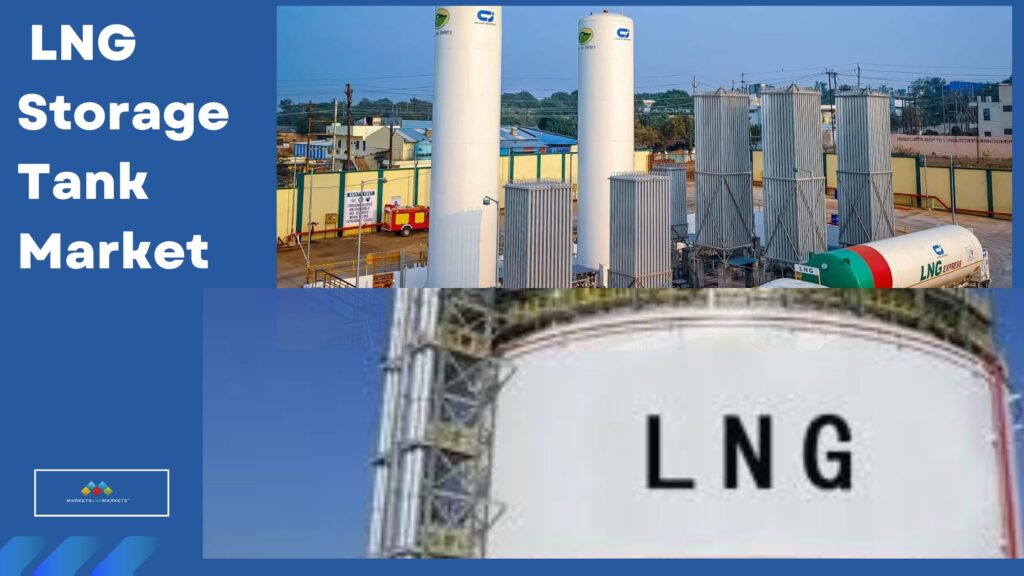
As the world continues to transition toward cleaner and more sustainable energy sources, Liquefied Natural Gas (LNG) is becoming an essential part of the global energy mix. Nations across the globe are striving to balance energy security with carbon reduction goals, and in this evolving landscape, LNG infrastructure—especially LNG storage tanks—has taken center stage. These tanks are no longer just a part of the supply chain; they’re strategic assets that enable safe, efficient, and scalable distribution of natural gas.
The LNG Storage Tank market is projected to reach USD 21.22 billion by 2029 from USD 14.64 billion in 2024, at a CAGR of 7.7% from 2024 to 2029. LNG Storage Tanks are a class of specialized storage tanks for LNG storage. These tanks are usually located in ground, above ground, and in LNG operated vehicles or ships. They are fabricated in different arrangements, including vertical, horizontal, double-walled, and insulated.
Let’s explore the dynamics of this critical sector.
LNG storage tanks are engineered to store liquefied natural gas at ultra-low temperatures—around -162°C. At this temperature, natural gas becomes a liquid, significantly reducing its volume and making it easier and more economical to transport and store. These tanks are built using specialized materials and advanced insulation systems that help maintain cryogenic conditions and ensure safety under extreme pressures. They serve as vital links in the LNG supply chain, enabling the seamless movement of gas from production plants to terminals and end users. Depending on operational needs and geographic constraints, LNG tanks come in two main types: above-ground tanks, which are easier to access and maintain, and in-ground or underground tanks, which are favored in space-limited or high-risk areas due to their added safety benefits.
As of 2023, the global LNG storage tank market was valued in the multi-billion-dollar range, and projections indicate a steady compound annual growth rate (CAGR) of over 6% through 2030. Several key factors are driving this momentum. First, there’s the global surge in LNG demand as countries look to move away from coal and oil. LNG is increasingly seen as a “transition fuel” that helps bridge the gap between fossil fuels and renewables, offering lower emissions and high energy efficiency.
Another major driver is the push for energy security. Countries like India, China, Japan, and Germany are significantly expanding their strategic LNG reserves to mitigate supply risks. This has led to increased investment in large-scale storage facilities, giving a notable boost to the tank market. Additionally, the maritime sector is turning toward LNG as a cleaner alternative to traditional marine fuels. As a result, the demand for LNG bunkering infrastructure—including port-based and onboard LNG tanks—is growing, especially in Europe and Southeast Asia. On the technology front, innovations in tank design, insulation materials, and modular construction are making LNG tanks safer, more cost-effective, and faster to deploy. Full-containment tanks and digital monitoring systems are also enhancing operational reliability, attracting more investment into the space.
Regionally, the Asia-Pacific market is leading in both growth and demand. Countries like China, India, and South Korea are rapidly building import terminals and expanding their LNG storage capacities to meet rising industrial and urban energy needs. North America is also seeing significant activity, driven by the U.S. and Canada’s vast shale gas resources and increasing LNG exports. The region is further focusing on small-scale LNG storage solutions to serve remote or off-grid areas. In Europe, the focus has shifted sharply toward energy diversification, especially in response to recent geopolitical tensions. Nations like Germany, France, and the Netherlands are fast-tracking LNG infrastructure projects to reduce dependence on pipeline gas, with storage tanks playing a central role.
Key players operating in the LNG storage tank market include McDermott International, IHI Corporation, Wartsila, L&T Hydrocarbon Engineering, and CIMC Enric. These companies specialize in engineering, procurement, and construction (EPC) of both onshore and offshore storage solutions. Their innovations and global reach are helping shape the next generation of LNG infrastructure.
Despite the optimistic outlook, the market is not without its challenges. High capital investment remains a significant barrier, particularly for developing countries. The complexity of regulations and the need to meet stringent safety standards also add layers of cost and time to project development. Additionally, fluctuations in global LNG prices can affect the pace of infrastructure expansion. However, collaboration between governments, private sector stakeholders, and technology providers is helping to ease these constraints through streamlined regulations, standardized designs, and new financing models.
Looking forward, the LNG storage tank market is set to remain a crucial part of the global energy transition. The next few years will likely see the emergence of floating storage and regasification units (FSRUs), growth in small-scale and mobile LNG solutions, and the broader adoption of digital systems for real-time monitoring and safety control. These trends point toward a more agile, resilient, and environmentally aligned LNG infrastructure landscape.
To Know More – Download PDF Brochure
In conclusion, the LNG storage tank market is more than just a support system for gas logistics—it’s a vital enabler of sustainable energy strategies worldwide. As countries invest in cleaner, more secure energy solutions, these tanks will continue to play a foundational role in powering industries, cities, and economies. For investors, energy professionals, and policy-makers alike, this is a space to watch closely in the years to come.
24World Media does not take any responsibility of the information you see on this page. The content this page contains is from independent third-party content provider. If you have any concerns regarding the content, please free to write us here: contact@24worldmedia.com

